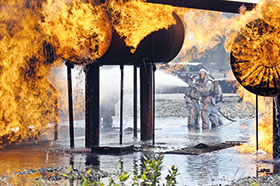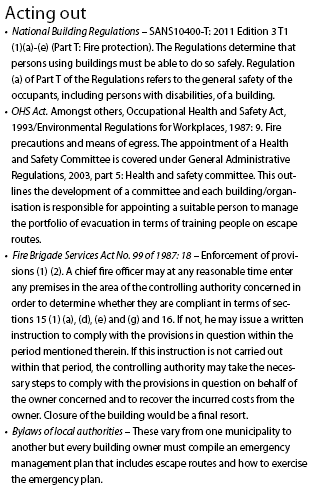

Hi-Tech Security Solutions looks at designing a system that addresses the safe exit of people from a burning building.
A fire has broken out in your office building, local shopping mall or hospital; or perhaps you are tripping the light fantastic in a nightclub. Fire alarms are sounding, there’s an underlying sense of panic and everybody has the same goal – get out of the building quickly and safely. Hi-Tech Security Solutions looks at designing a system that addresses the safe exit of people from a burning building.
There are a number of statutory regulations, bylaws and recommended rules around the planning, design and implementation of a safe escape route (see below). All these instructions are intended to provide a suitable plan of action that covers the moments immediately after a fire alert is received, right up until everyone exits the building in a safe and orderly manner.

It is critical that an appropriately-trained fire marshall be appointed to oversee any fire evacuation procedures and ensure that the necessary steps are adhered to. Perhaps, where the size of the building or number of people therein warrants it, an evacuation marshall can be appointed. Floor marshalls in multi-storey buildings will ensure that all people have left the floor for which they are deemed responsible. Where there is more than one fire marshall or evacuation marshall, then it is necessary to appoint a chief and deputies.
The fire marshall is responsible for training of staff, conducting fire prevention inspections, giving instructions to inform the fire brigade, making the ultimate decision to evacuate, organising teams to support the function and allowing people to safely re-enter a building. All members of staff in such buildings should be able to identify a fire alarm, whether it is audible, flashing or a combination of these, and be able to follow the evacuation procedure, as well as assist others (shopping centre customers and hospital patients).
Know and practice your processes
Nichola Allan of G2 Fire, says that typically, at least every three months there should be a full fire drill including evacuation of staff. However, the fire alarm itself should be tested every week and this testing should be set at a regular timeslot so staff are aware of the sound of a fire drill and therefore able to differentiate between a drill and an actual evacuation procedure.

Johan van den Heever of FPASA says that although there are prescriptive rules with respect to fire escape routes, buildings differ in design and use and, therefore, one needs to use a risk-based approach. Therefore, one needs to use a risk-based approach in terms of what the building is being used for; what is the design of the building; what is the population density, building location and status of people (awake or asleep, familiar or unfamiliar with the building, bedridden, mentally incapacitated, old and frail or young). The risk assessment will determine what the emergency evacuation design and plan looks like.
He says that there are various elements that need to be adhered to in terms of the specifications of SANS10400T, for example, the clear layer below the smoke layer should be 2,5 metres high for a period of at least 600 seconds. This is determined as the minimum requirement for people to escape and for firefighters to find the origin and seat of the fire. UK safety recommendations say that the average time for all people to reach a place of safety should be no more than 2,5 minutes.
The risk assessment should determine the place of safety to which people are directed by signage (green running man), with green directional arrows placed at every change in direction on the route. This could be a stairwell or the ground floor of a building or, ultimately, outside the building, in fresh air and at a suitable assembly point. The signage should be photo luminescent in accordance with the environment, hence it should be brighter in cinemas.
Van den Heever cites the example of a shopping centre, with a complicated layout and often-excessive travel distances. “One needs an emergency route that has various levels of non-negotiable safety, for instance, the place of safety provided by the emergency route should be within a concrete or brick and mortar room/passageway/stairwell if it is in a multi-level building; and it should be a non-combustible environment, with no gas pipes or other sources of combustion.
Stairwells have to be positively pressurised or ventilated where necessary and all access doors leading to emergency routes in multi-storey buildings have to be fire resistant. An essential is that one should not proceed from one area of risk to another area of risk and then to the place of safety. The route needs to be: area of risk to area of safety and, if necessary, onto another area of safety or directly to the exterior.
The escape route must be not more than 45 metres long and it is measured from the furthest point in the room of exit, to the escape door. If it is more than 45 metres away, then a feeder route needs to feed pedestrians to an emergency route with a door known as an access door. The next step would be to move people to the escape door which provides access to the exterior of the building.
Don’t be alarmed

Ian du Plessis of Sperosens, says that the situation where fire detection and alarm systems are to be installed are stipulated in the rules pertaining to the National Building Regulations. Generally buildings with large floor areas, high buildings, buildings in which people normally sleep and buildings designed for the gathering of people, need to be equipped with automatic fire detection and alarm systems.
An audible alert, accompanied by a flashing light/strobe is required for use in most buildings as most buildings must make provision for the physically impaired, such as people with hearing impairments. The current design specifications of these alarms are listed in SANS10139 and include sound output capabilities of 65-120 dB, depending on the environmental requirement. Sounders should always achieve 5 dB above the normal operating ambient noise and should be heard throughout the premises.
Allan points out that there is currently a new regulation in effect in Europe – EN54 Part 23 – which became a legal compliance in 2014. This means that beacons now need to illuminate the protected area at least 5 lux above ambient light levels. The net result is that you would see the flashing light even on a piece of paper or a keyboard you are working on in order to bring your attention to the incident. This legislation has not yet been brought into effect under the current SANS10139.
According to Van den Heever, the placement of the alarms depends on the layout of the building and should form part of the overall emergency preparedness plan, which is constantly evaluated. In factories where ambient noise is high, one should augment the audible alarms with visual strobes. In nightclubs, the system should, for instance, switch off amplifiers automatically so that the alarm can be clearly heard.
There are two methods of alarm activation: automatic and manual. In the first instance, fire detectors are placed in strategic locations where there is an identified risk of combustion being accelerated. Therefore, the detection system must be capable of producing an alert in the early stages of a fire. The detector then sends a message to the fire panel and this automatically activates the fire alarm. Manual call points include the provision of small red boxes with a break cover and a push button at strategic points. In multi-storey buildings, emergency centres (normally at the reception or in a security control room) are needed and all alarms will be routed through this centre.
Safety versus security
The question of whether to leave escape doors open to ensure safe through-flow of people or to keep doors locked to ensure that people are within a more secure environment is a seemingly tricky one. However, the National Building Regulations have taken the personal guesswork out of the equation by stipulating that one should be able to open an escape door in a single movement. The clincher here is that the door’s opening mechanism and hinges are on the inside of the building, so would-be criminals cannot open the door from the exterior of the building.
Du Plessis says that if a building has electronic locks, they must connect to the building’s automatic fire detection system to ensure that the door is automatically unlocked in the event of a fire. Furthermore, says Van den Heever, some building managers/owners connect the doors to the burglar alarm system. Therefore, when the intrusion detection system is disarmed, the magnetic switches in that zone on the door remain armed.
Allan explains that there are two distinct types of fire doors – external and internal. The external fire escape to the outside world or onto a common fire escape should be automatically closed with a standard door closer arm so that a fire cannot use the fire escape stairwell as a route to spread. The doors must always open in the direction of escape. An accepted lock would be a panic bar/push handle.
Access control but must have a green overriding switch that simply cuts the power to a failsafe lock. The use of keys/chains and padlocks should be avoided as these are difficult to use in a state of panic.
Internal fire doors separating fire compartments of the building are typically used in larger buildings like hotels and hospitals where building areas need to be structured in such a way that they prevent the fire spreading. They should be spring loaded to ensure that they are always closed. However, in hotels this can be an issue as guests with luggage need to keep stopping at multiple points to struggle with doors. In hospitals patients may need to be rushed between wards or surgery and it is not feasible to stop at multiple points to open doors.
“For this reason,” says Allan, “we fit door retainers which hold the doors open under normal circumstances. At the point of alarm, the fire system releases these retainers and the fire compartments are maintained until the event concludes. The staff can then re-open the doors and the retainers will be reactivated. Door holders wired to the fire alarm system can be used.”
Can you hear me?

Christopher Hlanganyana of Bosch Security Systems, says that while voice evacuation systems are not mandatory, they should be considered a critical part of the whole evacuation chain.
The problem with traditional fire detection systems that have sounders is that in most cases the interpretation of the alarm by various people can be vastly different. The main function of a voice evacuation system is therefore to enhance the reaction time of people by providing clear instructions on the situation and how to react.
Messages can be customised to specific building and environmental needs and can provide information on the location to which people should evacuate, providing details on exit areas and mustering points.
Hlanganyana says that there is a focus on the intelligibility of speech. “People should be able to hear messages clearly. Factors that need to be considered when designing the placement of speakers include the ceiling height and the ambient environment. The Speech Transmission Index for Public Address Systems (STIPA), which is also employed by Telkom, is used to measure intelligibility.”
The EN54 standards and SANS 7240 provide the requirements for voice evacuation products, system design, installation, commissioning and servicing. Bosch will inspect customer systems and provide compliance certificates for voice evacuations systems if they meet the stipulated standards.
He points out that one must be able to monitor all systems connected to the voice evacuation system with automatic supervision of the whole system provided by a main controller which is integrated with the fire detection system. He considers best practice to be a voice evacuation system that is triggered from a fire panel connected to fire detectors. “There is a marked advantage when using the Bosch fire detection and voice evacuation system together as they can be integrated using one CAT 5 or CAT 6 cable. This smart safety link system is particularly suitable to phased evacuation procedures.”
Conclusion
It is advisable to employ the services of an ECSA-registered fire consultant to design an escape route that considers aspects such as fire-resistant construction, smoke ventilation, marking of the route, alarms and emergency lights. There are five building regulations for fire protection and 59 deemed-to-satisfy fire requirements. A fire specialist can interpret these requirements, but to satisfy the engineering principles (rational design of the National Building Regulations) an engineer or engineering technologist should be undertaking the design.
All team players in a new building are responsible for certain elements in terms of the fire safety of the building. An architect considers the materials used; a structural engineer ensures that the structural fire resistance is adequate; the mechanical engineer will ensure that the materials and workway are according to standards; the electrical engineer ensures that enough power is provided for ventilation and emergency lights; the electronic engineer is responsible for fire detection and its interaction with other security systems such as activating a smoke alarm, switching off the air-conditioning, deactivating lifts, and activating fire curtains; the acoustical engineer ensures that the voice evacuation system is adequate and functional. The fire engineer may actually have influence over all these aspects. In essence, therefore, ensuring that people leave the building safely in the event of a fire, is a multi-modal and multiple responsibility undertaking.
| Tel: | +27 11 543 5800 |
| Email: | [email protected] |
| www: | www.technews.co.za |
| Articles: | More information and articles about Technews Publishing |
© Technews Publishing (Pty) Ltd. | All Rights Reserved.